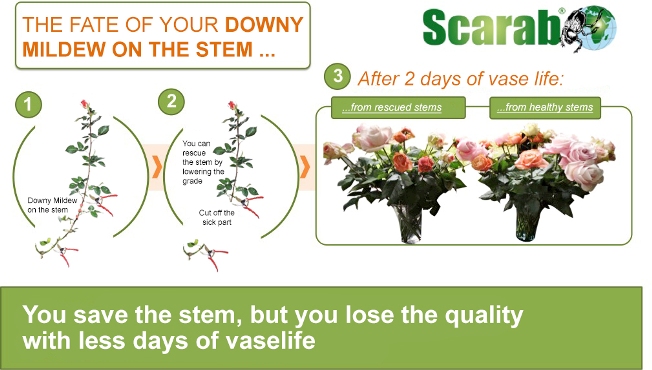Dr Lisbeth Riis, founder and CEO at Scarab Solutions, has discussed how tackling downy mildew requires preventive measures, effective scouting, early intervention and regularly executed control
Downy mildew (Peronospora sparsa) is among the most feared diseases in industrial rose production in the highland tropics. Outbreaks are triggered when the presence of inoculum coincides with high relative humidity (> 85 per cent, > three to four hours), cool temperatures (10-18°C) and free moisture on the leaves persist for four hours or more. Young apical tissue is by far the most susceptible part of a plant. Prevention, early detection and rapid intervention, and a zero-tolerance policy on the farm are important to its control in susceptible varieties.
When downy mildew takes hold
The first symptoms visible to the naked eye are purplish-red, brown or blackish angular spots on the upper side of the leaf restricted to areas between major leaf veins. Under humid conditions (>85 per cent RH) grey to brownish erect sporangiophores will form on the underside of the leaf and conidia will spread from here by air currents and water splashes.
Sporulation will not always be present underneath the leaves, but likewise, the potential risk is very high as soon as environmental conditions are favourable. Purple patches can form on stems, peduncles, floral sepals and petals.
The latency period for downy mildew is relatively short with visible symptoms appearing four days after infection and sporulation at five days. Therefore, semi-weekly crop monitoring is recommended during time when environmental conditions are favourable for Downy Mildew.
What happens to the stem?
On the stems, easily recognisable purple patches of two cm or more can be observed, and sometimes combined with longitudinal cracking of the stem and under very humid and moist conditions white mycelial growth can sometimes be observed.
Farm technicians have argued that downy mildew in stem can be dealt with by cutting off the sick part of the harvested stem and thus meet production expectations.
The full impact of downy mildew s hidden until the unacceptably short vase life is discovered. Growers ought to know and closely follow the status of stem downy mildew in the rose crop before harvest – this is why the Scarab Precision monitoring system takes downy mildew in stem very seriously and such findings put farms on high alert.

How to establish control
Rose varieties differ greatly in their susceptibility and tolerance to downy mildew, but many of the susceptible varieties are in high demand and fetch a good market price. Here are the five stages of reducing the likelihood or minimizing the impact of downy mildew in rose greenhouses.
Prevention
Prevention by means of climate control is ideal, but for those without such technology, prevention relies on good hygiene and ventilation (except during downy mildew sporulation). Fungicides, such as potassium phosphites, copper phosphites or fosetyl-aluminium, also important in the plant’s early life, help suppress outbreaks of this disease to a certain extent.
Hygiene
Hygiene is critical to reduce the presence of downy mildew, as sporangia can remain viable on dried fallen leaves for up to one month and carefully removing the debris around the plants, without stirring up the sporangia into the air, can help reduce the presence of spores.
Ventilation
Providing good air movement and keeping the greenhouse well ventilated through appropriate plant spacing, raised roofs, raising curtain walls during times of water condensation in the air, and installing industrial fans (except during downy mildew sporulation) to keep the relative humidity below 85 per cent is crucial, but difficult during rainy and cool conditions.
Cut and remove
Beyond the preventive measures, when detected, spraying curatively to avoid the spread of spores and subsequently cutting and carefully removing affected plant parts directly into bags and immediately sealed.
Fungicides
For those who don’t have climate management, the control of downy mildew relies heavily on chemicals and to avoid the build-up of resistance, it is critical to apply different active ingredients with different modes of action as established by the Fungicide Resistance Action Committee (FRAC).




